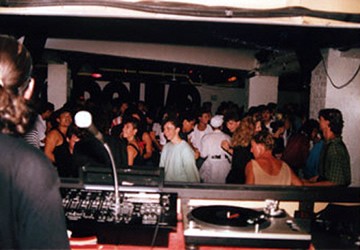
The dance floor at the Playground, about 1987, seen from the DJ’s booth
The rise of club culture
The music scene in New Zealand’s largest city, Auckland, is dominated by electronic music and DJ culture. This dance floor revolution is a relatively recent phenomenon, which began in the early 1980s.
According to Simon Grigg, Auckland club life began with A Certain Bar, opened by pop star Peter Urlich and Mark Phillips in 1981. With backing from legendary entrepreneur Phil Warren, they then ran the hugely popular Six Month Club in (pre-Aotea Centre) Cook St. Following that building’s demolition, Urlich, Phillips and Grigg opened The Brat in Nelson Street with DJ Roger Perry – formerly of the underage club The Venue, run by an ambitious young musician/actor called Russell Crowe.
In 1986 Grigg and Perry quit The Brat to open, with Tom Sampson, the Asylum at the cavernous Galaxy venue (later Powerstation) in Mount Eden. ‘It was a fortuitous time to open a big, rough and noisy club,’ Grigg recalled. ‘Revolution was in the air. The so-called Golden Age of Hip Hop was breaking.’ The Asylum’s sound was:
Simple, functional, very loud with a mix of hip hop, soul, Def Jam, pop and this new sound that Roger and I became hooked on. It was called house music, and the Asylum can claim to be the place where house started in New Zealand.

Roger and Simon also managed to persuade student station bFM to give them a radio show, Asylum FM, on Saturday afternoons. This was New Zealand’s first dance radio show, ‘much to the dismay of the bFM mafia who stood outside the studio and sneered at the “disco” we were playing.’ Grigg and Perry later moved on to the Playground in Nelson Street and then Siren, downstairs in High Street. In the early 1990s Siren became The Box, with the bar Cause Celebre next door. Grigg recalls:
Celebre was firstly and foremost about jazz, soul and funk – and it was the best bar in town for years. It was the place where all the touring acts came, where Tom Jones bought girls Moet, where Eric Clapton sneered at Jimmy Barnes, where Hall & Oates were barflys, where Ice T lay on the floor singing ‘My Funny Valentine’ or where Mick Jagger tried to get in free ([doorman] Riseti said he could afford $5 and had to pay ... he did).
By the late 1990s dance music and DJ culture were firmly established in Auckland and in most other New Zealand cities. When Chris O’Donnohue’s Lightspeed Productions began importing international DJs in 1997, the era of the large dance party began – and with it, according to Grigg, ‘the explosion in dance culture which so dominated Auckland in the next few years.’

This Siren poster is from 1990, when DJ Roger Perry left for a spell in the United Kingdom.
Links
- Auckland club history part 1 (Simon Grigg)
- Auckland club history part 2 (Simon Grigg)
- The Box and Cause Celebre (Simon Grigg)

Community contributions